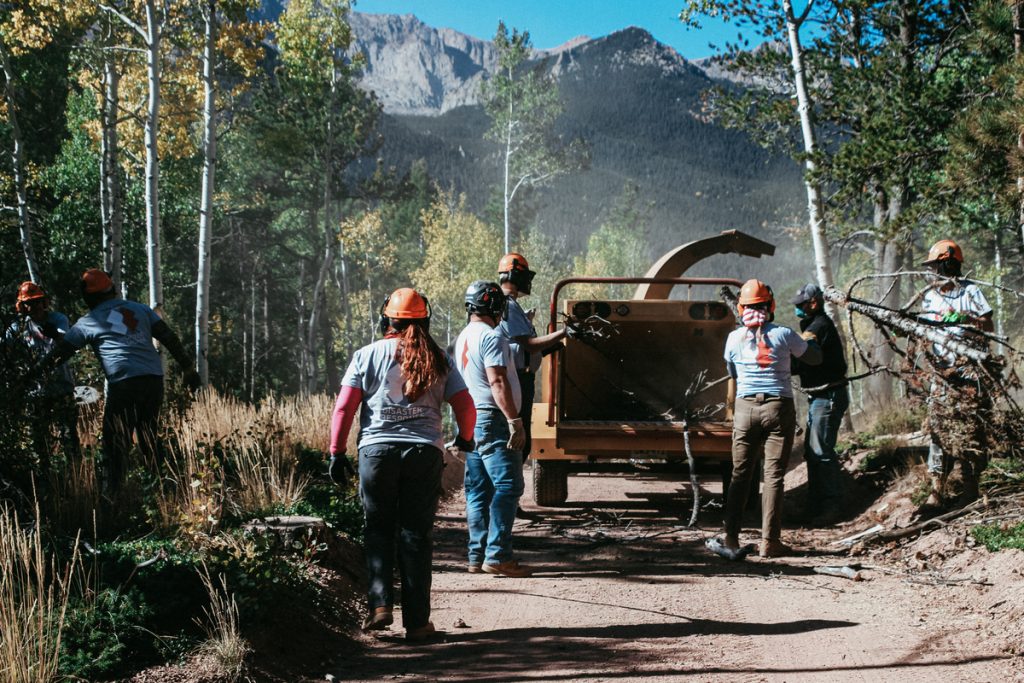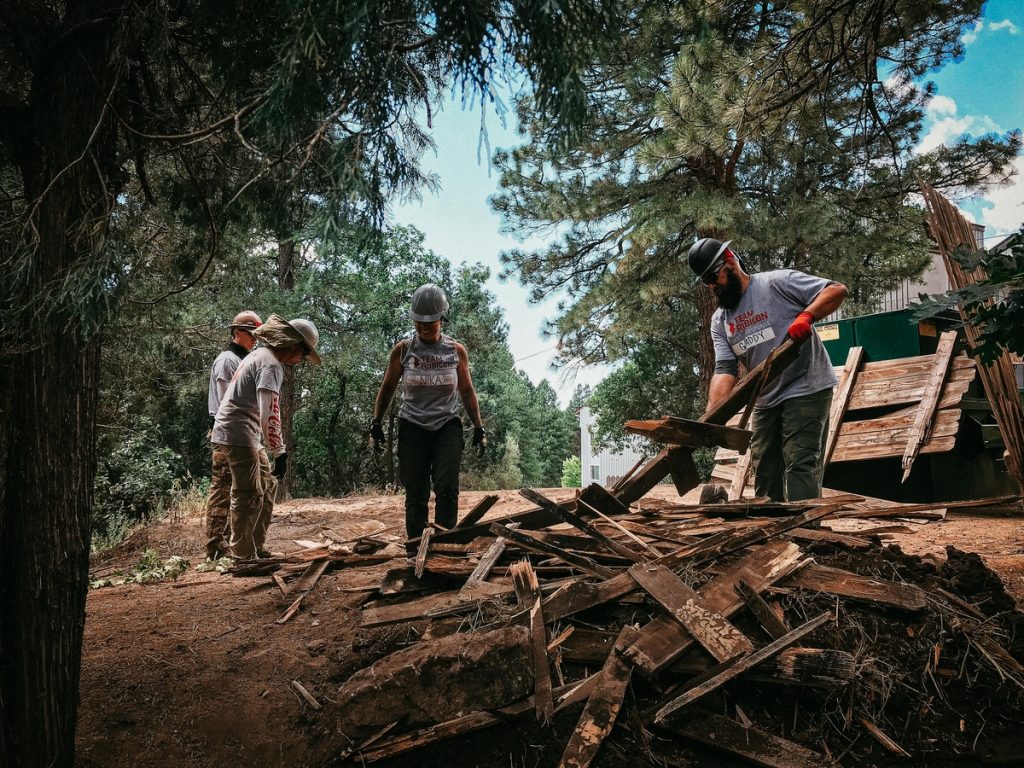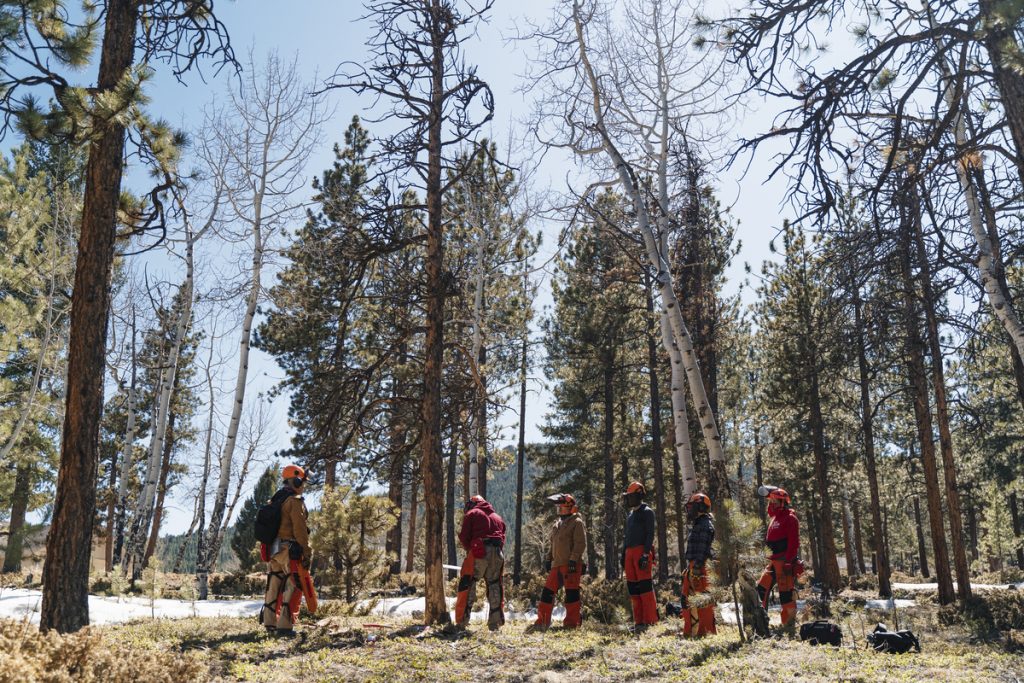For Wildfire Mitigation, Send in the Volunteers
For years Greyshirts have responded after natural disasters. Now, they're taking on wildfire prevention.
Turn on the news during the summer months, and you’ll likely find it filled with stories of wildfires ravaging landscapes with homes and communities in their path, particularly in western states. According to a 2020 report from the National Interagency Fire Center, the U.S. averages approximately 70,000 wildfires per year. Over the last two decades, an average of 7 million acres per year were lost, devastating communities, destroying wildlife habitats, and creating public health hazards in the process.
While 2020 was the worst wildfire season on record—more than 10.1 million acres in the U.S. burned—the worst is likely still to come. Going into the summer, California already faces historic drought conditions and reservoirs across the state are shriveling. While a small portion of the state is in moderate drought conditions, the majority is listed in severe, extreme, or exceptional drought conditions according to the National Drought Mitigation Center at the University of Nebraska-Lincoln, NOAA, and the USDA. The Golden State is not alone with its severe drought and increased fire danger: according to the Drought Monitor severe drought conditions stretch across the northwest U.S. and nearly all of Nevada, Utah, Arizona, and North Dakota—and a good swath of Colorado—are experiencing extreme and exceptional drought conditions.
As experts predict increasingly worse fire seasons in the coming years, and as more people move into wildland urban interface zones that are prone to wildfire outbreaks, wildfire mitigation efforts have never been more important. Now, the disaster relief nonprofit founded by veterans, Team Rubicon, is stepping up efforts to fight fires before they start.
Wildfire mitigation—versus wildfire prevention—is a relatively new approach to land management. In the 1930s, the U.S. Forest Service’s stated goal was to extinguish any fire by 10 a.m., but eliminating those small brush fires had an unintended consequence: without them, small shrubs and other debris only served to fuel larger, more devastating fires. By the 1970s, the Forest Service began letting certain wildfires burn where appropriate. Now, it’s a common practice in vulnerable areas to learn to live with wildfires by making communities more defensible. Reducing ground fuels around homes and roads can not only slow the spread of fire, it can make firefighting both safer and more effective.
In Colorado, Sawyer Training and Wildfire Mitigation Make For Win-Win
Team Rubicon has already been playing a role in wildfire mitigation through its sawyer training program, and it’s been a perfect fit: high-risk communities need help clearing brush and dead trees to make their communities safer, and sawyers need opportunities to train with chainsaws and maintain their proficiency. In recent years, however, Team Rubicon has recognized an opportunity to expand its menu of services and formalize its wildfire mitigation program.
In early 2019, leaders reached out to local emergency management officials in Estes Park, CO, to coordinate a training and team-building project in the local area that would coincide with Team Rubicon’s national leadership conference. When Larimer County Emergency Services recommended Glen Haven as a potential location for sawyers to do wildfire mitigation, the two organizations got to work.

After reviewing the Glen Haven Community Wildfire Preparation Plan and walking through several of the high-risk worksites, both groups decided to focus their efforts on a narrow dead-end road that had the highest probability of becoming impassable during a wildfire, putting residents of the 50 structures in the area at risk. In August 2019, a team of Greyshirts from the leadership conference worked under the guidance of an experienced forester to create defensible zones in the area. They’ve continued to return to Glen Haven multiple times since.
Colorado Greyshirt Bernie Lodge has participated in a number of exercises in Glen Haven. “We cleared roads and got rid of the woody debris that acts as ground fuel, and removed a lot of ladder fuel,” which are low- hanging branches that, when ignited, can send a fire upward into the canopy where flames spread rapidly.
When the Cameron Peak Fire broke out in Colorado in August of 2020 then marched into the Glen Haven area in October, a number of homes in the area were, unfortunately, lost. Yet the fuel reduction Team Rubicon crews had performed saved many structures and helped prevent the wildfire from moving into a more heavily populated area.
Lodge was gratified to see the Greyshirts’ fire mitigation tactics had worked. “The fire had less fuel to move across, so the thinning did exactly what it was intended to do,”.
Glen Haven Fire Chief Kevin Zagorda was also surprised at the outcome. “I was astounded at how many houses had been burned right around and had been still standing,” he told news outlets.
Fire Break Helps Citizens and Firefighters in California
A similar story played out last fall in Silverado, CA, where Team Rubicon State Administrator Kevin Kothlow has been working in partnership with fire safe councils to provide wildfire mitigation through sawyer training for several years.
In October, Greyshirts cleared a 200 yard by 100 yard section in Modjeska Canyon to act as a firebreak, explained Kothlow. In December, a fire started on the ridgeline behind it. “It didn’t burn right up to where we had cut, but we learned later that the aerial tankers and firefighters used our strip of land as their defense position,” Kothlow said. “So, that was cool for us.”
In addition to carving out these larger community firebreaks to help check the spread of wildfire, sawyers are often called upon to assist individual residents with protecting their homes by removing debris and dead trees within 100 feet of a residence.

“We get to the people that don’t really have the resources to do this work,” Kothlow said. Often that includes seniors, low-income residents, and disabled homeowners. “The Fire Safe Council gave us a list of 14 homes last year, and we’ve got another 18 this year. And we go there and basically do their yard work for them. I think last year we did 48 trailer loads to the dump.”
It’s work that’s meaningful for the people Team Rubicon serves. Idyllwild resident Tim Gilbert received assistance from Team Rubicon and the Mountain Center Fire Safe Council in June of last year. When a brush fire broke out not far from his home six months later, he was placed under mandatory evacuation orders. In a letter he wrote to the crew who worked on his property, Gilbert noted that he felt much more at ease knowing his property’s fire issues had been addressed. For that peace of mind, he wrote, he was very grateful.
Kothlow read that letter aloud to his team during the Silverado operation. “I don’t want people to start thinking this is just yard work,” he said. “It’s much more than that. This is having a real impact on people’s lives.”
Wildfire Mitigation Work Gives Disaster Relief Volunteers Rare Chance to Provide Prevention
Every year, Team Rubicon responds to disasters like hurricanes, tornadoes, and flooding—and sometimes even assisting with recovery and cleanup after wildfires. The organization isn’t, however, in the business of fighting fires. What it can do is help mitigate against them. So, after seeing the effectiveness of mitigation firsthand, Team Rubicon decided to take a more active role in the process, and formalize the organization’s role and responsibilities in this area.
“We’ve been doing this kind of work for years, but we haven’t separated it from response,” said Southwest Deputy Director Mike Gorham. “We’re really trying to separate this out so that everyone can understand the nuances of mitigation versus other response activities.”
Part of the wildfire mitigation offerings will include strengthening partnerships with local fire departments, emergency services, and community groups to aid in creating defensible spaces around individual homes and broader communities.

“We just bring our resources to bear,” Gorham said. “We rely on fire departments and their expertise to provide the framework of the work that we’re going to do at each project site.” That includes tasks like putting sawyers to work thinning forest growth, having volunteers clear tinder-ready vegetation, and having Greyshirts do the heavy lifting of creating fire breaks near homes and communities.
Such mitigation work gives Greyshirts a rare opportunity to provide disaster prevention instead of disaster response.
“We’re not going to try and prevent any wildfires, but we can reduce the likelihood that they’re going to have a significant impact on communities,” Gorham said. “We can, however, help control the rate and be the direction of the burn to help firefighters with their work.”